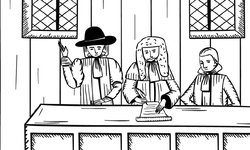Key Stage 3 History: Survivors of the English Civil War
Teacher's notes
- Level
- Key Stage 3
- Theme
- British History 1509 to 1745
- Description
- Using Civil War Petitions for teaching Key Stage 3 History
- Lesson plan
- Lesson Plan
- Handouts
- Film Quiz handout The County Court handout The County Court (learning from home) handout Pop the Petition handout
The English Civil War broke out in 1642 between the supporters of King Charles I and Parliament. Before the war, they had argued over religious policy, foreign policy and taxation. Charles had even tried to rule without Parliament between 1629 and 1640.
In 1646, King Charles I was forced to surrender and he gave himself up to the Scottish army at Southwell in Nottinghamshire. This was an attempt to secure a deal, but the Scots handed the King over to Parliament in exchange for money that was owed to their soldiers. The King was imprisoned. Whilst apparently negotiating a settlement, he engineered a Second Civil War. Some Parliamentarians felt it was impossible to make peace with the King. He was tried and executed for treason in 1649.
The period between 1649 and 1660 is known as the Interregnum. The country was a republic which means it had no king. However, from 1653 until his death in 1658, Oliver Cromwell ruled England as Lord Protector. He was succeeded by his son Richard. Richard was removed from power by the army after six months. Following a period of confusion, Charles I’s son was invited to return to England as King in 1660. He was known as King Charles II. The return of the King was called the Restoration.
Activities
Click on the pictures below and complete the activities (includes learning from home options)
Interested in Finding out more?
Explore more on the Civil War Petitions website. Look for a petition that interests you. You could choose a petition that has a gory wound or is from a person who lived near you. You might even find a petitioner who shares your name! Was the petition successful? Can you identify any of the strategies in this petition that match the successful strategies you learned about in the lessons? Use the buttons below to access the Civil War Petitions website. Visiting the National Civil War Centre in Newark is a great way to learn more about the Civil War. A trip to the National Civil War Centre can include a re-enactment of the trial of Charles I. Don't worry, if you can't travel there - digital versions of this trip are available for schools who are unable to travel. Find out more details below.Find out more
Click on the buttons below to access the Civil War Petitions website and discover what's available at the National Civil War Centre





